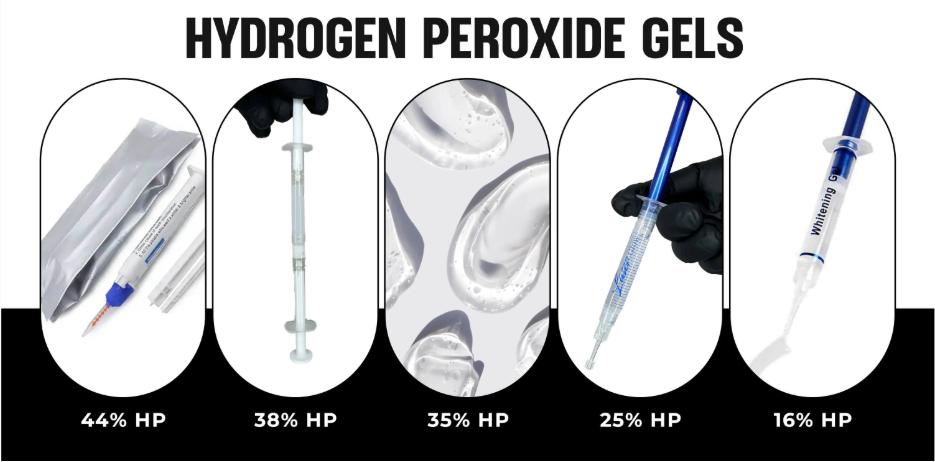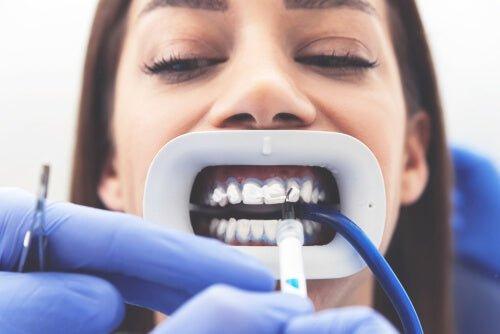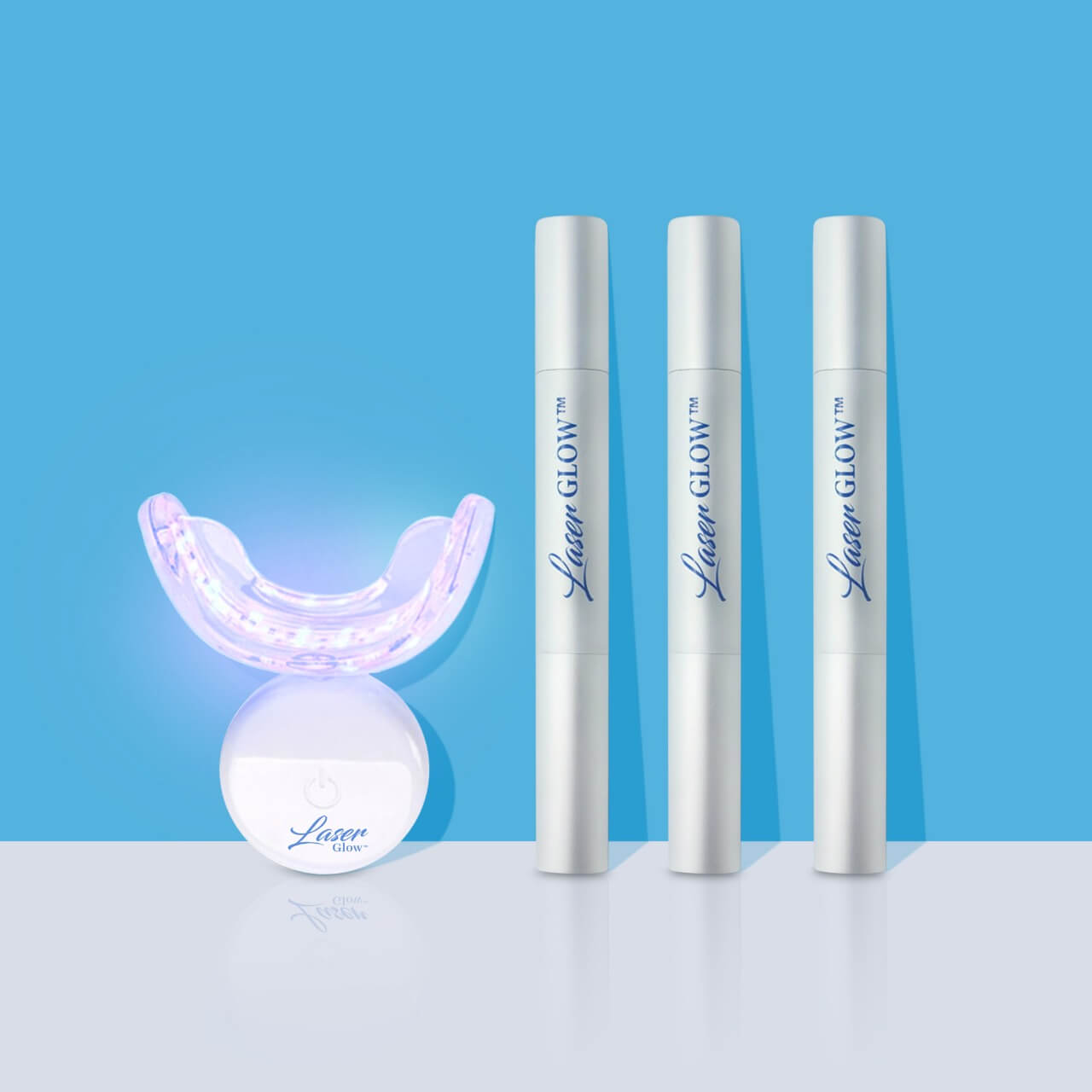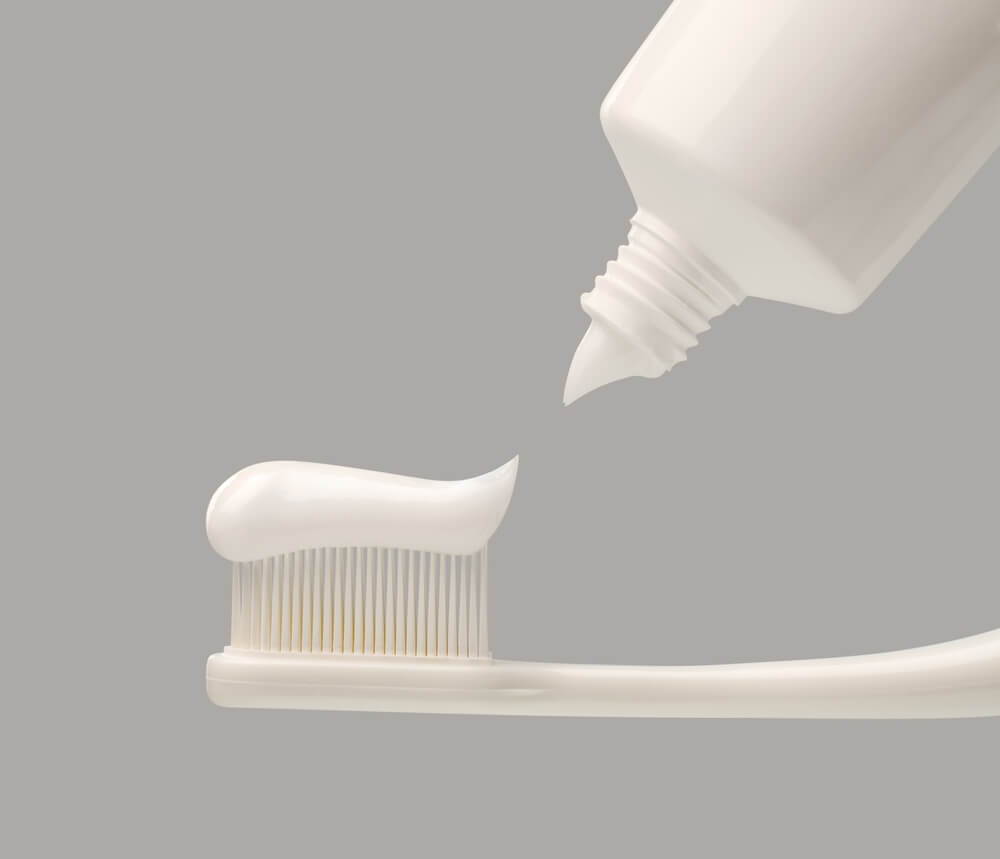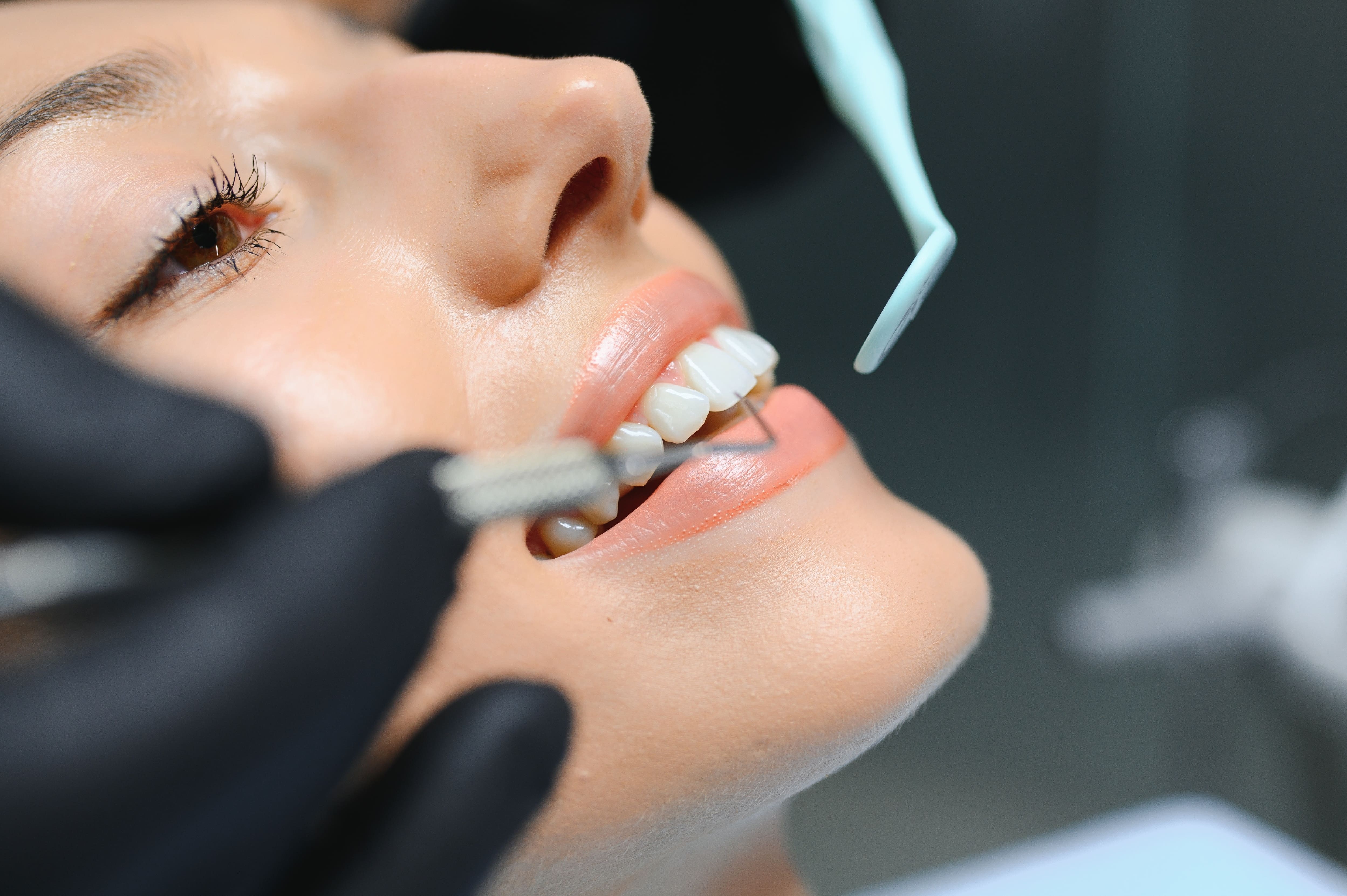Porcelain and composite veneers give you a bright, flawless smile – but over time you might notice them losing a bit of luster. Many patients wonder, “Can you whiten veneers once they stain?” The truth is that veneers don’t respond to bleaching gels like natural teeth do. However, that doesn’t mean you’re out of options. In this comprehensive guide, we’ll explain why veneers can appear discolored, how to safely remove stains from veneers, and what you can do to keep your veneer-enhanced smile white for years to come. We’ll also answer all the frequently asked questions about whitening veneers, so you can protect your investment and confidently show off your smile.
Can You Whiten Veneers with Teeth Whitening Products?
The short answer is no – you cannot whiten the veneer material itself using typical peroxide whitening products. Unlike natural tooth enamel, which is porous, dental veneers are made of non-porous materials (porcelain or composite resin) that do not respond to bleaching agents. Even high-strength whitening gels or strips will not penetrate or alter a veneer’s color.
Attempting to bleach veneers at home won’t make them any whiter, and it could irritate your gums or damage your natural teeth without any benefit to the veneers. Standard whitening treatments only work on natural tooth structure, so applying them on veneers is ineffective. In fact, dentists and the American Dental Association caution that while veneers are generally stain-resistant, “they cannot be lightened once they begin to change color”.
That said, your smile is not doomed to discoloration just because you have veneers. What can be whitened is often the tooth structure around or behind the veneers, and surface stains that build up on the edges of veneers over time. In the next sections, we’ll look at why veneers might appear dull or yellow as years go by – and how to safely refresh them.
Why Do Veneers Look Discolored Over Time?
High-quality porcelain veneers are designed to be stain-resistant. In fact, porcelain is a glass-like ceramic that doesn’t pick up pigment easily. Composite resin veneers (and bonding) are a bit more porous, so they can stain slightly faster than porcelain. But all veneers can start to look less bright after many years due to several factors:
- Surface Stains at the Margins: Dark-colored foods and drinks – coffee, tea, red wine, curry, berries, tobacco – can leave micro-deposits on the tiny seam where the veneer meets your tooth. Over months and years, these pigments accumulate in the edges and between teeth, making the borders of each veneer appear yellow or shadowed.
- Aging of Bonding Cement: The adhesive resin that bonds the veneer to your tooth can discolor over time. As this dental cement ages or if your gumline recedes exposing it, you might see a darker line or slight color change at the top of the veneer.
- Natural Tooth Changes: If you had veneers only on some teeth, the surrounding natural teeth might change color (darken or get whiter if you bleach them) and create a contrast. Even the tooth behind a translucent veneer could darken slightly with age. This can make the veneer look less bright by comparison.
- Wear and Surface Roughening: Years of brushing and consuming acidic foods can very slowly wear down the ultra-thin glaze on a porcelain veneer or the polish on a composite veneer. A rougher surface can attract stains more easily. While porcelain veneers are more resistant to discoloration than composites, neither type is 100% immune to the effects of time. Composite veneers in particular may absorb stains and lose luster faster due to their resin makeup.
In short, veneers themselves typically don’t deeply yellow the way natural teeth can, but the little things – surface stains, edge discoloration, minor changes underneath – can add up to a smile that isn’t as sparkling white as it once was. The good news is that these types of discoloration can usually be addressed with proper maintenance or professional care, which we’ll discuss next.
How to Safely Remove Stains from Veneers
Even though you can’t bleach a veneer whiter than its original shade, there are safe and effective ways to refresh your smile if veneers have taken on stains or a dulled appearance. Here are the best practices for whitening the appearance of veneers:
1. Professional Dental Cleanings: Just as your dentist or hygienist polishes your natural teeth, they can also polish the surface of veneers during a routine cleaning. Regular professional cleanings (every 6 months) help remove surface stains and plaque that make veneers look dull. The polishing paste and tools used by dental professionals can gently buff away many extrinsic stains without harming the veneer. This is often the first and easiest step to brighten your veneers.
2. Cosmetic Veneer Polishing: If a basic cleaning isn’t enough, ask your dentist about a dedicated polishing session for your veneers. Dentists have special fine abrasives and polishing discs that can be used on porcelain or composite veneers to restore their glossy shine. This can significantly improve mild staining or surface roughness. Polishing won’t change the inherent color of the veneer, but it can remove buildup and re-smooth the surface, making them appear brighter.
3. Non-Abrasive Stain Removing Toothpaste: Use a toothpaste formulated for veneers or for whitening without abrasives. Ordinary whitening toothpastes might contain gritty particles (or baking soda) that could scratch porcelain over time. Instead, choose a gel-based fluoride toothpaste or one marked “safe for cosmetic dental work.” These often contain gentle polishing agents that help lift surface stains from veneers without eroding their finish. While such toothpastes won’t dramatically whiten a discolored veneer, they can help maintain brightness and prevent new stains. (Avoid charcoal pastes or any “DIY” abrasive scrub on your veneers – more on that in the FAQ!)
4. Specialized Veneer Whitening Treatments: One exciting development is professional veneer stain-lifting sessions – a targeted form of in-office whitening designed specifically for people with veneers. For example, our LaserGlow offices in Clifton and Edgewater, NJ offer a 20-minute veneer touch-up that uses a concentrated hydrogen peroxide gel and LED light to brighten the edges of veneers. Unlike a full teeth whitening session (which can last 60–90 minutes but doesn’t change porcelain), this short treatment focuses only on oxidizing the stains lurking around each veneer. By applying the whitening gel precisely along the margins where veneers meet enamel, we can lift the yellowish tinge from those micro-gaps without “over-whitening” the porcelain itself.
Why try a 20-minute veneer whitening? Here are some benefits:
- Targets Stains at the Edges: The short peroxide application is concentrated on the stained margins instead of the porcelain front, effectively breaking down pigment where it accumulates most.
- No Color Mismatch: Because the porcelain veneer material isn’t altered, you won’t end up with uneven color. The treatment simply erases the dark shadows so your veneers return to their original shade.
- Minimal Sensitivity: Less exposure time means less risk of tooth sensitivity after. Many patients find this micro-whitening causes little to no post-treatment soreness, an ideal perk if the teeth under your veneers have thin enamel.
- Quick & Cost-Effective: In about 20 minutes, you can see a noticeable improvement in veneer brightness. Since you’re only using a fraction of the chair-time and materials of a full whitening session, the cost is often much lower as well. (Nationwide, a standard one-hour in-office whitening can cost $400–$600, whereas a veneer-focused touch-up might be under $200.)
This type of specialized treatment is a safe way to refresh your veneers periodically without replacing them. Always ensure it’s done by a dental professional familiar with cosmetic dentistry.
5. Replacing Old Veneers: What if your veneers are truly discolored internally or have had their outer glaze compromised? Unfortunately, no amount of cleaning will fix deep internal stains or intrinsic color changes in a veneer. In rare cases – such as veneers older than 15-20 years, or those damaged by cracks – the best solution might be to replace them with new veneers. This is the most invasive and costly option, so dentists typically reserve it for when veneers are significantly discolored or defective beyond the help of polishing. The upside is that new veneers can be made in a brighter shade if desired. With good care, a new set of porcelain veneers will last a decade or longer before any notable discoloration occurs.
Most patients will not need to replace veneers just for mild staining. By using the above methods – regular cleanings, proper toothpaste, occasional professional touch-ups – you can keep your veneers looking nearly as bright as the day they were placed.
Pro Tips for Keeping Veneers White
While professional treatments can help when veneers get dingy, the ideal scenario is to prevent stains in the first place. Good oral habits will protect both your veneers and your underlying teeth and gum health. Follow these best practices to maintain a radiant veneer smile:
- Practice Excellent Oral Hygiene: Brush your teeth (and veneers) twice a day with a soft-bristle toothbrush, and floss daily. Plaque buildup can make veneers look dull and also contribute to staining at the edges, so keeping your mouth clean is key. Consider using a water flosser to clean around veneers – water flossers can reach and rinse out plaque from the small nooks around veneer margins more effectively than string floss.
- Avoid Stain-Causing Foods & Drinks: Limit your consumption of very pigmented items like coffee, black tea, red wine, cola, soy sauce, curry, and berries. When you do enjoy them, rinse your mouth with water afterward or brush if possible to prevent long contact with the veneer surfaces. Using a straw for drinks like iced coffee and tea can also minimize contact with your front teeth.
- Skip the Tobacco: Do not smoke or chew tobacco if you want to keep your smile bright. Nicotine and tar are notorious for staining dental work. Smoking will yellow your veneers over time and can also stain the bonding material around them, not to mention harm your gums. Quitting tobacco is one of the best things you can do for your veneers (and overall health).
- Use Non-Abrasive Dental Products: As mentioned earlier, use gentle toothpaste and avoid abrasive pastes or DIY whitening concoctions on your veneers. Products with baking soda, charcoal, or gritty texture can create microscopic scratches in porcelain, making it easier for stains to latch on. Also choose alcohol-free mouthwash – alcohol can weaken the bond of the veneer adhesive over time.
- Regular Dental Checkups: See your dentist every six months for cleanings and exams. Not only will they polish your veneers, but they’ll also check the integrity of the bonds and look for any issues (like gum recession or decay at the edges) early on. Routine maintenance will keep your veneers and the teeth supporting them healthy and looking good.
- Consider a Color-Correcting Rinse/Paste: If you need an instant boost before a big event, you can try a purple-tinted whitening toothpaste or mouth rinse as a temporary fix. These products don’t bleach teeth but use color theory (purple cancels yellow) to give a brighter appearance. They are safe on veneers because they simply deposit a slight tint that makes teeth look whiter for a short time. It’s like make-up for your teeth – just be sure to use it as directed and continue your normal cleaning routine too.
By following the above tips, you’ll greatly reduce the chances of your veneers getting stained. Prevention is always easier than cure when it comes to keeping cosmetic dental work pristine.
Veneer Teeth Whitening in NJ & FL – A 20-Minute Solution
If you’re looking for a quick, safe way to refresh your veneers and you live in New Jersey or South Florida, our team can help. LaserGlow offers a specialized Veneer Teeth Whitening service available at our offices in Clifton, NJ, Edgewater, NJ, and Miami, FL. In just 20 minutes, our trained dental professionals will lift the stains from around your porcelain or composite veneers using a high-intensity peroxide gel and LED light activation. This targeted treatment is designed specifically for veneers – it brightens the areas around the veneers without changing the veneers’ actual color, so you get a rejuvenated smile that looks natural and even.
Our Veneer Whitening touch-up is performed by licensed hygienists, and we use enamel-safe gels with protective measures to ensure your gums and underlying teeth stay healthy throughout the process. Most clients see 1–2 shades of improvement at the veneer margins after one session. If you’re in the Clifton, Edgewater, or Miami area, feel free to contact us to book a consultation or appointment. We’ll help you maintain your veneers and keep your smile glowing!
Frequently Asked Questions about Whitening Veneers
Can you whiten veneers?
No. You cannot whiten the porcelain or composite material of veneers using bleaching treatments like you would natural teeth. Traditional whitening gels “bounce off” the veneer’s non-porous surface without any effect. However, you can improve the overall brightness of your smile by removing stains on the tooth structure around veneers or polishing the veneer’s surface. Professional cleanings or specialized in-office veneer whitening (stain-lifting) treatments are the best way to make veneers look whiter.
How can I whiten my veneers at home?
Unfortunately, there is no safe or effective at-home method to truly whiten veneer material. Whitening strips, LED kits, or gel trays won’t change a veneer’s color. Even “natural” remedies like baking soda or peroxide won’t whiten veneers – the veneers simply don’t respond to these agents. In fact, abrasive home remedies (baking soda, charcoal, lemon juice, etc.) can end up damaging your veneers or the teeth around them. The best thing you can do at home is maintain excellent oral hygiene: brush and floss regularly, use a non-abrasive toothpaste, and avoid stain-causing foods and smoking. These habits will prevent further discoloration. If your veneers still look dull or yellow, the next step is to visit your dentist for professional cleaning or a veneer-specific whitening service.
Do veneers stain or turn yellow over time?
Porcelain veneers are very stain-resistant, so they generally do not yellow like natural teeth can. Composite resin veneers are a bit more prone to surface staining over the years. That said, both types can develop slight discoloration at the edges or a duller appearance after long-term exposure to staining agents. Common culprits for veneer staining are coffee, tea, red wine, tobacco, curry, and similar substances. Also, if the adhesive bonding your veneer darkens or your gums recede, you might see a line or gap that looks yellowish. Veneers themselves won’t dramatically change color, but they can lose some brilliance after 10-15 years. Regular dental maintenance and mindful habits will minimize any yellowing.
What’s the best way to remove stains from veneers?
The most effective way is to have your dentist or hygienist professionally clean and polish the veneers. A thorough polishing can often take off external stains. If stains persist, ask about a specialized veneer whitening or stain-lifting treatment – some cosmetic dentists offer a focused whitening procedure to brighten veneer margins (for example, a 20-minute in-office veneer touch-up). Do not try to aggressively scrub veneers at home (like using baking soda scrubs) as you could scratch them. Always opt for professional care for stain removal on veneers. In extreme cases where a veneer is deeply discolored internally, you may need to replace it with a new one.
Will whitening toothpaste or strips work on veneers?
Standard whitening toothpastes or whitening strips have little to no effect on veneers. Those products are formulated to remove stains from natural enamel and bleach the enamel’s color. Since veneers are artificial material, strips won’t penetrate them. Whitening toothpastes might help clean around the veneers, but if they contain abrasives they can also wear down the veneer’s shine. If you use a whitening toothpaste, make sure it’s a gentle, non-abrasive type. Overall, don’t expect these products to actually whiten the veneers themselves. They are better used for keeping your surrounding teeth bright so there’s no contrast.
Can I use baking soda or charcoal to whiten veneers?
No – it’s not recommended. Abrasive substances like baking soda or activated charcoal powder may scour away surface stains, but they also risk scratching your porcelain veneers and damaging the enamel at the margins. Acidic DIY concoctions (like lemon juice or apple cider vinegar) are equally bad, as they can erode the tooth surface around the veneer and even cause the edges of veneers to stain more by roughening them. In fact, dental experts warn that home remedies (lemon, baking soda, etc.) can ironically end up staining veneers or causing other issues. It’s best to stick to dentist-approved cleaning methods for your veneers.
Will professional teeth whitening damage my veneers?
If you have your teeth professionally whitened (for example, the natural teeth that don’t have veneers), it will not damage the veneers. The whitening gel will simply have no effect on the porcelain, and it won’t harm it. Porcelain is quite inert – peroxide gel passes over it without changing its color or structure. Just be aware that whitening your other teeth could make your veneers appear relatively darker if the veneers were originally matched to a previously darker shade. Also, the whitening process can cause temporary sensitivity in natural teeth, but it should not hurt or weaken your veneers. As always, it’s wise to have whitening done under professional supervision, especially if you have cosmetic dental work.
How often should I whiten or polish my veneers?
Veneers themselves don’t need whitening, but to keep them looking their best you might want a “touch-up” periodically on the areas around them. Most patients with veneers get a professional cleaning every 6 months, which usually suffices to remove minor stains. If you opt for a specialized veneer stain-lifting session (like the 20-minute whitening touch-up), you might do that once a year or every 6 months depending on your diet and habits. Patients with composite veneers or heavy coffee/red wine use may benefit from more frequent maintenance (e.g. a polishing or touch-up every 3-6 months). Your dentist can recommend an ideal schedule. The key is to avoid letting stains build up too long. With regular care, many veneer wearers find they rarely need anything beyond their routine cleanings to keep a white smile.
Do composite veneers stain more than porcelain?
Yes. Composite resin veneers are generally more prone to staining than porcelain veneers. Porcelain is highly stain-resistant and maintains its color very well over time. Composite is a plastic-based material that can absorb pigments slightly, so composite veneers may yellow or dull faster, especially if exposed to lots of coffee, wine, smoking, etc. Composite veneers also typically last 5-7 years before they might need refurbishing, whereas porcelain veneers last 10-15 years on average. If you have composite veneers, be extra diligent with hygiene and avoiding stains, and you might need professional polishing or more frequent replacement to keep them at peak brightness.
What if my veneers are severely discolored or old?
If you feel your veneers have become very discolored deep down (not just surface stains), consult your dentist. They will check if the staining is external or internal. External stains can usually be cleaned off or polished. Internal discoloration – which can happen if a veneer’s glaze is worn or if the tooth behind has darkened – cannot be lightened without altering the veneer itself. In such cases, the dentist might suggest replacing the veneer with a new one, especially if the veneer is at the end of its lifespan. Another scenario is if the edges of veneers are picking up stains due to tiny gaps or cracks; sometimes re-bonding or reglazing the veneer can help. Ultimately, replacing the veneers is the definitive solution for severe or intrinsic discoloration. The new veneers can be made in a brighter shade, so replacing them will definitely whiten your smile, albeit at a higher cost than other options.
How much does veneer whitening cost?
Simple stain removal is often done as part of a regular cleaning, which might cost around the same as a normal dental visit (depending on your insurance or local rates). If you opt for a cosmetic veneer whitening session, the cost is typically a fraction of a full teeth whitening procedure. For example, an hour-long in-office whitening can cost about $400-$600, and yet it won’t change veneer color. A targeted 20-minute veneer stain-lifting treatment might cost roughly $150-$200 because it’s shorter and focuses only on the stained areas. Prices vary by location and provider, so check with your cosmetic dentist. Replacing veneers entirely is the most expensive option – usually $1000+ per tooth – so it’s worth investing in maintenance to prolong the life of your existing veneers.






